From Cory: In my online marketing for artists classes, I often end up helping artists develop some writing skills. “I’m not a writer,” is an excuse I hear all of the time. But the truth is that good writing is essential – I’m so glad to have Paul share some his favorite artists who write here.
This is a guest post from painter Paul X. Rutz.
Helpful guidance comes in two forms. When it’s labeled as advice, it’s easy to spot. At the Abundant Artist you’ve taken in the great tips about how to write a statement to go with your work, and you’ve read this on how and why to write an engaging sales page for your website. You’ve digested the key points here on how important it is to make emotional connections with your audience. This is valuable stuff, and like many of you I’ve used it to reconsider my marketing plan.
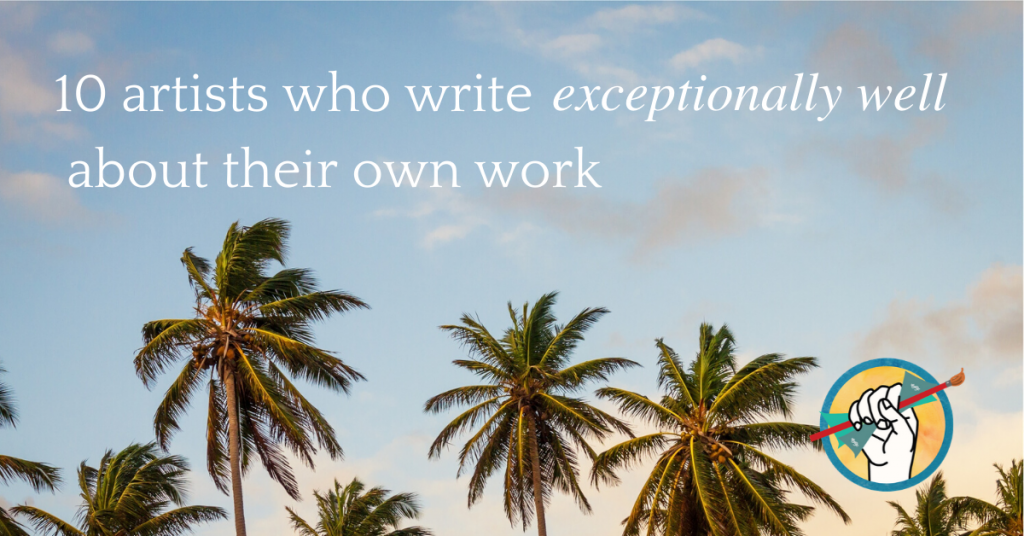
This post is about the next step in finding helpful guidance: Reading good writing by artists who know how to frame what they do in compelling verbal packages.
Why?
Writing is here to stay. The more success you have growing your audience and selling your work, the more opportunities you’ll find to communicate about it. The need to write well will come from everywhere: in pitches to potential collectors, press releases, discussions over social media, artist talks, workshops, and even guest blog posts.
Yes, writing about our own work can be tough. We painters, photographers, collagists and sculptors are visual thinkers. It’s hard to put into words why we sanded down that spot or how we decided the piece was finished—not to mention expressing the larger meanings behind these decisions, or describing how the work will hum with energy in a viewer’s living room. But we’re all writers. Whenever we make a friend laugh via text or email, we’re practicing the skills we need to engage our audience and keep the recognition and sales going.
And the great thing is…
When it comes to writing about our work, it’s easy to stand out because the bar is low. Lots of visual artists hate writing, so they don’t put any creative energy into their writing. They follow a template and just get it done. As a result their writing is packed with clichés and vagaries instead of personality. That cycle perpetuates itself, and they hate writing even more.
That’s why reading great writing by visual artists is so important.
The following list offers writing by a variety of artists at the top of their game, all bending language to convey the passion behind their work. These people communicate in wildly different ways. Their voices vary from Banksy’s flip anarchism to Doris Humphrey’s professorial modernism, and they’re all weaving compelling stories about how and why they do what they do. Digesting those voices—noticing the moves they make as they describe their work—will help you hone your own writing. (I’ve included links to online content where available.)
I’m not suggesting we copy directly from anyone on this list. Instead, we should take them as ten examples of good marketing. Telling a compelling story about your work and effectively selling that work often look like the same thing.
One more thing:
Read not just for facts; read for flavor. When a piece of writing grabs you, pause. Ask how it’s doing that. How is the passage organized? What kinds of verbs does the writer use? What’s the formatting like? Make a note to self about what works. Take the helpful guidance laid out in front of you. You’ll learn more than how these artists think about their own work. You’ll start to see how to better communicate what you do, too.
I’ll start with some helpful guidance actually labeled as advice:
1. Twyla Tharp
The Creative Habit: Learn It and Use It for Life, 2005
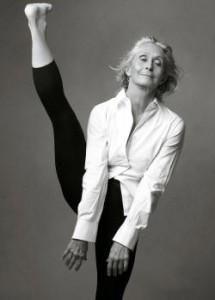
This book is packed with great tips: How to foster good work habits, shift your daily routine, set better creative goals, and move from scratching for ideas toward fully realizing them. Tharp has worked as a top ballet and Broadway choreographer for five decades. She writes, “Creativity is a habit, and the best creativity is a result of good work habits. That’s it in a nutshell.” In a chapter titled, “Build a Bridge to the Next Day,” she explains how she cleans the overnight clutter in her mind to keep herself on track. Don’t miss her advice on reading: “If I stopped reading, I’d stop thinking. It’s that simple.” (I’ve written more about this key point here.) Tharp is also an advocate of going out and getting it. She writes about wanting to do a musical based on Billy Joel’s music. Instead of asking him for permission first, she started work on Movin’ Out, then showed excerpts to Joel. When he saw the dance, he exclaimed he never thought his songs could look so good and gave his permission to her on the spot. More to the point of this blog post: With her direct, upbeat writing style, Tharp shows us her world, and why she’s such a compelling choreographer. This advice book makes me want to watch more of her dances, not just follow her advice.
2. Scott McCloud
Understanding Comics, 1993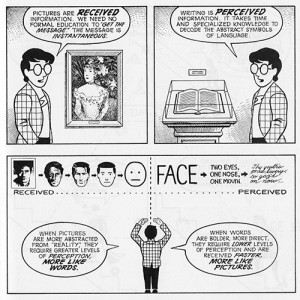
This book marries good rhetoric with creative fun: a comic book arguing for the place of comics as fine art. McCloud’s main character takes us through the history of Western art. He offers tips for how to use words and images together to create tension, show a character’s state of mind, or just get the point across. Through it all McCloud gets to show off his considerable skill as a writer and illustrator. Here’s a sample.
3. Maya Lin
“Making the Memorial,” 2000
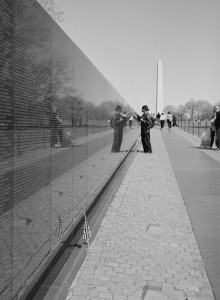
Published in 2000, but mostly written in 1982 right after she completed the Vietnam Veterans Memorial in Washington DC, this essay explains the origins of Lin’s most famous earth sculpture and my favorite memorial. I love this view through the eyes of the younger Lin, a college student who studied memorials of the past then used the blind contest to design this new memorial as her final project for an architecture seminar. Pulled into fame and controversy after her anonymous entry was chosen, she navigates her design through a world of prejudiced know-it-alls. Art in this essay is both deeply personal and communal—it’s personal vision and negotiation.
4. Doris Humphrey
The Art of Making Dances, 1958
Composed as a kind of textbook for choreographers, this book lays out the basic design concepts that are fundamental to American modern dance. Humphrey clearly explains the thinking behind how she grouped people on stage and how she organized lots of people into a complicated stage presentation. The book ends with a checklist, a series of aphorisms such as “Monotony is fatal; look for contrasts” and “A good ending is forty per cent of the dance.” I know two successful writers who have used this checklist to guide them in their own poetry and essay writing. Each part of the list gets fleshed out with an explanation. My favorite is “All dances are too long.” In other words, edit, edit, edit…
5. Banksy
Wall and Piece, 2005
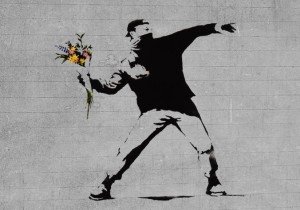
If you’ve seen the film Exit Through the Gift Shop, you know what this famously anonymous British man (or woman or collective or whatever Banksy is) can do with a story told by unreliable narrators. Whatever you think of Banksy’s work—whether it’s brilliant, or a series of juvenile pranks—how he discusses what he’s up to is really sophisticated. In his book Wall and Piece, he captions hundreds of photos of his graffiti with political screeds, humorous asides, and anecdotes about how he works. Banksy gets to play both prankster and pundit, and both practitioner and critic. At the opening of the book, he writes, “The people who run our cities don’t understand graffiti because they think nothing has the right to exist unless it makes a profit. But if you just value money then your opinion is worthless.” That kind of tight, provocative writing expands his body of nighttime street vandalisms into relevant commentary. Another favorite quote from the book: “Policemen and security guards wear hats with a peak that comes down low over their eyes. Apparently this is for psychological reasons. Eyebrows are very expressive and you appear a lot more authoritative if you keep them covered up. The advantage of this is that it makes it a lot harder for cops to see anything more than six foot off the ground. Which is why painting rooftops and bridges is so easy.” Throughout, he mixes his beliefs about the foolish hubris of those in authority with practical experience like this.
6. Vincent Van Gogh
Letters, 1873-90
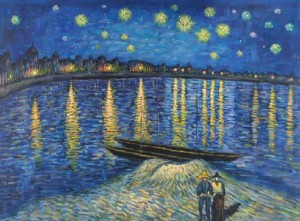
Van Gogh is our essential model of the crazy, starving artist—the man who legend has it cut off his own ear and killed himself in despair. But reading his actual words, I get the impression of a dedicated and highly observant man constantly thinking about his craft and working at it with patience. This online trove of more than 900 letters is translated and searchable by date, location, correspondent, and whether the letters contain sketches. Sometimes they’re full of business. Sometimes gossip. Often they overflow with rich descriptions of his surroundings, the complicated colors of things, and his attempts to study it all in paint. It’s hard to find writing more packed with enthusiasm for painting.
7. Philip Glass
Words Without Music, 2015
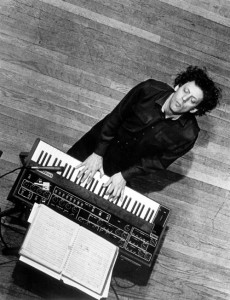
Ok, composer Philip Glass isn’t exactly a visual artist, and he isn’t the most refined writer. He writes in direct, unpolished prose, the way he talks in interviews. But it works! That’s why I’m including his new memoir here. The takeaway is you don’t have to be a fabulous writer to make a big impact with your writing. Glass tells his story of dedicated study, daily work (including driving a cab until age 41), bad reviews, and the slow, slow road to recognition without much stylistic hoopla, but his hunger to make music and his willingness to experiment are everywhere in this book: “If you don’t know what to do, there’s actually a chance of doing something new. As long as you know what you’re doing, nothing much of interest is going to happen.”
8. Henri Cartier-Bresson
The Decisive Moment, 1952
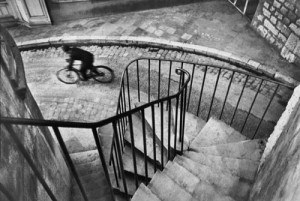
This famous book of photos is also one of the rarest. Last year, it finally got a long overdue reprint, but it’s still way too expensive. Part advice, part memoir, the introductory essay expertly sets us up to see his work. (A pdf of the essay is here.) The book cemented Cartier-Bresson’s reputation as one of the most important photographers of the 1930s and 40s, and his writing shows his thinking about that work in discreet sections: “The Subject,” “Composition,” “Color,” and so on, ending with “The Customers.” He asks what photography is and what it isn’t—how photography hovers between the unfolding truthful present and the layers of selection the photographer makes during and after the shot.
9. Errol Morris
Believing Is Seeing, 2011
This book is a collection of essays that started here, on his New York Times blog, and it probes how we believe our way into the truth of images: “Believing is seeing,” he writes. “Not the other way around.” A former private eye, Morris built his reputation as a documentary filmmaker on the pursuit of Truth, with an obsessive, somewhat cranky personality. He doesn’t fit most people’s picture of “artist,” but his writing shows his tenacious commitment to his craft. I trust Morris to take me somewhere special with his films after reading what he writes in these essays. He somehow indulges in the beauty of images and takes them apart at the same time, spelunking deep into fascinating questions, including why forgeries fool us.
10. Sally Mann
Hold Still, 2015

My interest in reading Sally Mann comes from many places. Like Errol Morris, she uses her knowledge of photography to ask important questions about how images matter in our culture, but unlike him, she’s documenting her family and friends. When she discusses her work, she blends her personal history with her photography seamlessly. In her memoir, Hold Still, she takes a hard look at how her photographs have affected the people around her. There’s a beautiful mix of the personal and the philosophical here. At one moment, she explains her belief that photographs “rob all of us of our memory” by replacing other sensory associations—smell, sound, and so on—with an image made by a machine. But in the next moment, she might explore how those limitations have brought about some scary situations for her family. For example, Mann is most famous for making photos of her naked children playing on their Virginia farm. In her memoir she tells the story of how those photos were received (harshly) and the repercussions she and her family endured. Check out this online excerpt from the book to find that story. This is excellent writing by a photographer wrestling to balance her love of the medium with its limitations and consequences.
I read these bits of writing for a lot of reasons, including the chance to glimpse how human and full of doubt these people often were on their way to achieving something remarkable. Everyone has struggles, and many of theirs were far more serious than mine.
This list reflects my own tastes and biases, of course. (And those are always changing. I used to be all about painter Gerhard Richter’s cagey little essays and the Zen-infused dance interviews of Merce Cunningham.) I’m an art world mutt, who danced ballet seriously for a while, worked as a writer/photographer for a news service, and did a grad degree with a heavy focus on film. Although I make my living as a painter, I get most of my ideas on how to write about painting from people who do other things. As I read more, my list of favorites will keep adjusting.
Do you have other examples of favorite writing by artists about their own work? Please share them in the comments.
Paul X. Rutz works as a figurative painter in Portland, Oregon, and enjoys writing about it. Find his recent work here: paulrutz.com.
Must Read: Do check out our definitive guide to an artist’s website for further insights, The Ultimate Guide to an Artist’s Website.
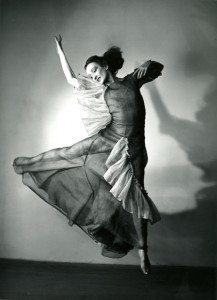
Really enjoyed this post! Thanks for compiling this helpful list. The link to Van Gogh’s letters doesn’t seem to be working – is it online elsewhere by any chance?
Hi Kent,
Thanks for pointing out that link problem. Try this: http://vangoghletters.org/vg/
Best regards,
Paul Rutz
Fantastic blog post! I have book marked and will delve further into each creatives journey.
Thank you very much.
Great post!!!
I have just started writing about my work after reading this and also setting up a mutual show and tell art group in my local town. Wow writing about ones work is a bit like what I have been wanting to get out of setting up a show and tell group..to get that feeling of really looking under the surface of our motivations and not lose site in the pressure to make and sell, what the deeper undercurrents that pull us to create are. Great thing about writing is you can ramble for as long as you need!! I think it is really going to enhance my art from talking so directly to my arty self too. Excited…Thank you.
As a photographer, I find writing a necessary evil. And that’s not because I am not a good writer. I have been writing from a young age. It’s simply that beyond a profile description, or a brief expose’ on the particular image, the image should takes care of its own message.
If I write more than that, I feel I am writing more than needed.
Hi Rich,
I agree there’s a lot we should leave unsaid when we present our visual work. I’m not suggesting writing (or another form of communication) should take the place of photos or paintings. I also believe when we put our work on the wall or the plinth or whatever, we’re giving away our authority to dictate meaning. Whether we like it or not, viewers are going to take whatever message they want from what they see (as Sally Mann learned painfully). But writing is still inevitable. Your reply to my post is an example. It’s a piece of the atmosphere of writing that flows around the visual work we do. And you wrote it well.
Best regards,
Paul Rutz
I hear you, Paul. I am an abstract artist and I can also write…that is not so much of the problem. The challenge is that in telling my story I am identifying myself and my work (boxing it in, if you will) as I see it and not allowing the viewer the space to have his own ideas of receiving the art in his own mind. With abstract art as well as with photography I believe, is to already have told a compelling story. To then sell the piece to another is to feel like I am leading my viewer to what they ‘should be’ looking at. And obviously this is what ‘selling’ is about and to push the viewer into falling in love with you and buying our works. But… ‘selling’ my own work makes me feel compromised and not true to my abstract’s ‘soul intention’. That soul intention is to have an effect of freedom and to free the viewers mind …not box it in. Perhaps this response happens in me because I put the work itself ahead of my own view and intention of it. Perhaps my works are like my children…I have ideas for their future but I don’t want to influence them or talk about them, to the degree that they lose their own mind.
You are a very similar mutt to me! Dance, film, photography and a love of words. i have not yet tried painting. Loved this list. Jean Cocteau was always an inspiration to me, for his multi-passionate approach to the arts, but I am unaware that he wrote anything specific about his habits. I am going to reread my copy of Twlya Tharp’s book and order Sally Mann’s…Oh! Suggestion would be Patty Smith’s book….Just Kids….although that was less about her habits and more about her life and colleagues/loved ones. But still stirring.
Thanks for the great post.
Hi Antonia,
I haven’t read Patty Smith. She’s going on my list of books to get from the library…
Thanks!
Paul Rutz
Thanks for this list, I will have to check them out further. I have been struggling to learn to write descriptions of my jewelry. I don’t merely want to give them a list of what I made it with, I want to learn to write about the sparkle and the beauty and more. It has been a real struggle for me. I’ve been studying what other online jewelers are writing and have been trying to practice writing my own. Guess you post falls write in line with my struggle.
I’m off to read and learn now!
Hi Cory, Paul
I’d love it if you check out my writing and let me know what you think. It’s not always related with my painting but I just can’t help talking about what I want to talk about.
I’ve been studying how to market my work for about a year now and I’m certain that online success has to do with my voice as an artist. However, this runs counter to most advice I find of focusing on a niche and servicing a specific audience. This feels like nails on a chalkboard! —I want to paint and say what I want to paint and say when I want to do it! It’s like the last bastion of freedom I have, the very reason why I paint!
Anyway, I’d love to hear your opinion. Thanks.